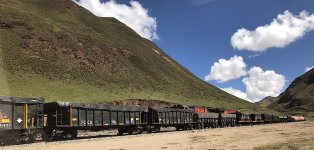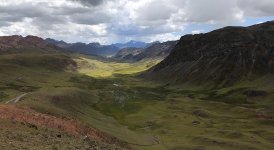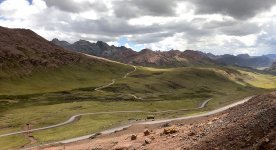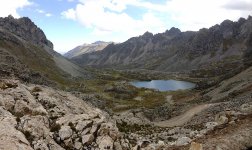MKinHK
Mike Kilburn

You might indeed Jos!
Best of all, as we covered the final corner of the mossy bog, and the whole reason for this dash to the roof of Peru was a breathtakingly wonderful family party of four Diademed Sandpiper-Plovers. One of the birds I’ve wanted to see ever since I got the first edition of Shorebirds in the late 1980s, I was gutted to get within 50km of a site last year in northwest Argentina’s altiplano without having the chance to look for them. But there they were – calmly feeding about 25 metres away – similar in size to a Pectoral Sandpiper, with grey upperparts, a broad chestnut nuchal collar, a tattler’s finely-vermiculated underparts, yellow legs, a square steep-fronted head with a grey crown, black face, white throat and it’s diadem - an elegant white supercilium that angled down from the forecrown above the downcurved black bill.
The juveniles were less distinctive – with a chestnut and black-speckled back and upper breast, a grey rather than black face, no collar, a less clearly marked belly and a fainter diadem. They were also less wary, coming considerably closer as they fed amongst the pincushion moss. As amazing as the Many-coloured Rush Tyrant was it just couldn’t compete with the combination of thirty plus years of dreaming and the incredible setting of a 4,600m high marsh surrounded by peaks reaching 5,000 and beyond!
With the main mission resoundingly accomplished we headed on up and over the ridge and into another superb peak-ringed valley where more searching finally delivered the ultra range-restricted White-bellied Cinclodes sitting on a roadside rock. Looking twice the size of the other cinclodes the White billed had a different jizz again – being longer tailed and larger-bodied and distinctly pot-bellied, with chestnut wings, dark tail and an iron-grey cap. Unfortunately it did not hang around, and with more than three hours to get back to the airport neither could we, and stopping briefly to search fruitlessly for Andean Tinamou, we headed down along route 116 through the Santa Eulalia valley through a dramatic landscape of small blue lakes and increasingly arid slopes.
It was here where the lost time of the morning really hurt – as we drove by terrific looking habitats that hold a number of restricted range species. We did collect eight Silvery Grebes on one of the lakes and managed to pull Slate-breasted and Mourning Sierra Finches, plus Hooded Siskin and the truly spectacular Black Siskin out of the finch flocks around the upper reaches of the valley, and drive-by Golden Grosbeak, several Bare-faced Ground Doves, two White-capped Dippers, Spot-winged Pigeons and three Yellow-billed Teals a little further down. The road through the central third of the canyon was cut into a vertical sandstone cliff and it tool a real effort to fight off the sense that one false move would terminate the trip as swiftly as a bigger rock would have done earlier in the day. The driver Alejandro, even if he drove just a tad faster than I was comfortable with epitomised my “always go for the old dudes” motto for mountain birding trip – they’ve survived a long time!
I was delivered safely back to the airport with two hours to spare, adding a couple of Belcher’s Gulls feeding in a rubbish-strewn river , twenty or so Black Vultures and last bird of the trip – an Amazilia Hummingbird pillaging a very bedraggled roadside bush as we edged round a roundabout just short of the airport road. After 5 days of jet lag and the 3am start that morning I was sleep before we left the ground. As usual I'd be very happy to provide more details should anyone be interested.
Cheers
Mike
Best of all, as we covered the final corner of the mossy bog, and the whole reason for this dash to the roof of Peru was a breathtakingly wonderful family party of four Diademed Sandpiper-Plovers. One of the birds I’ve wanted to see ever since I got the first edition of Shorebirds in the late 1980s, I was gutted to get within 50km of a site last year in northwest Argentina’s altiplano without having the chance to look for them. But there they were – calmly feeding about 25 metres away – similar in size to a Pectoral Sandpiper, with grey upperparts, a broad chestnut nuchal collar, a tattler’s finely-vermiculated underparts, yellow legs, a square steep-fronted head with a grey crown, black face, white throat and it’s diadem - an elegant white supercilium that angled down from the forecrown above the downcurved black bill.
The juveniles were less distinctive – with a chestnut and black-speckled back and upper breast, a grey rather than black face, no collar, a less clearly marked belly and a fainter diadem. They were also less wary, coming considerably closer as they fed amongst the pincushion moss. As amazing as the Many-coloured Rush Tyrant was it just couldn’t compete with the combination of thirty plus years of dreaming and the incredible setting of a 4,600m high marsh surrounded by peaks reaching 5,000 and beyond!
With the main mission resoundingly accomplished we headed on up and over the ridge and into another superb peak-ringed valley where more searching finally delivered the ultra range-restricted White-bellied Cinclodes sitting on a roadside rock. Looking twice the size of the other cinclodes the White billed had a different jizz again – being longer tailed and larger-bodied and distinctly pot-bellied, with chestnut wings, dark tail and an iron-grey cap. Unfortunately it did not hang around, and with more than three hours to get back to the airport neither could we, and stopping briefly to search fruitlessly for Andean Tinamou, we headed down along route 116 through the Santa Eulalia valley through a dramatic landscape of small blue lakes and increasingly arid slopes.
It was here where the lost time of the morning really hurt – as we drove by terrific looking habitats that hold a number of restricted range species. We did collect eight Silvery Grebes on one of the lakes and managed to pull Slate-breasted and Mourning Sierra Finches, plus Hooded Siskin and the truly spectacular Black Siskin out of the finch flocks around the upper reaches of the valley, and drive-by Golden Grosbeak, several Bare-faced Ground Doves, two White-capped Dippers, Spot-winged Pigeons and three Yellow-billed Teals a little further down. The road through the central third of the canyon was cut into a vertical sandstone cliff and it tool a real effort to fight off the sense that one false move would terminate the trip as swiftly as a bigger rock would have done earlier in the day. The driver Alejandro, even if he drove just a tad faster than I was comfortable with epitomised my “always go for the old dudes” motto for mountain birding trip – they’ve survived a long time!
I was delivered safely back to the airport with two hours to spare, adding a couple of Belcher’s Gulls feeding in a rubbish-strewn river , twenty or so Black Vultures and last bird of the trip – an Amazilia Hummingbird pillaging a very bedraggled roadside bush as we edged round a roundabout just short of the airport road. After 5 days of jet lag and the 3am start that morning I was sleep before we left the ground. As usual I'd be very happy to provide more details should anyone be interested.
Cheers
Mike
Attachments
-
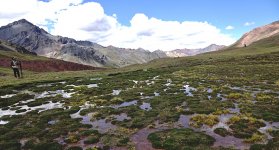 DSC05214 Pincushion Marsh @ Santa Eulalia.jpg606.3 KB · Views: 32
DSC05214 Pincushion Marsh @ Santa Eulalia.jpg606.3 KB · Views: 32 -
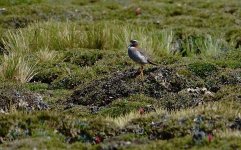 DSC05228 Diademed Sandpiper-plover @ Santa Eulalia.jpg658.9 KB · Views: 50
DSC05228 Diademed Sandpiper-plover @ Santa Eulalia.jpg658.9 KB · Views: 50 -
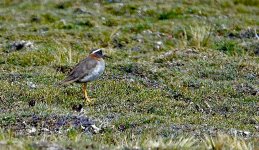 DSC05218 Diademed Sandpiper-Plover @ Santa Eulalia.jpg754.8 KB · Views: 55
DSC05218 Diademed Sandpiper-Plover @ Santa Eulalia.jpg754.8 KB · Views: 55 -
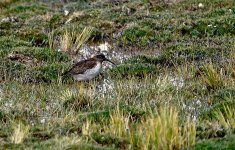 DSC05213 Diademed Sandpiper Plover @ Santa Eulalia.jpg840.4 KB · Views: 43
DSC05213 Diademed Sandpiper Plover @ Santa Eulalia.jpg840.4 KB · Views: 43 -
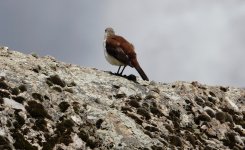 DSC05242 White-bellied Cinclodes @ Santa Eulalia.jpg458 KB · Views: 45
DSC05242 White-bellied Cinclodes @ Santa Eulalia.jpg458 KB · Views: 45
Last edited:





